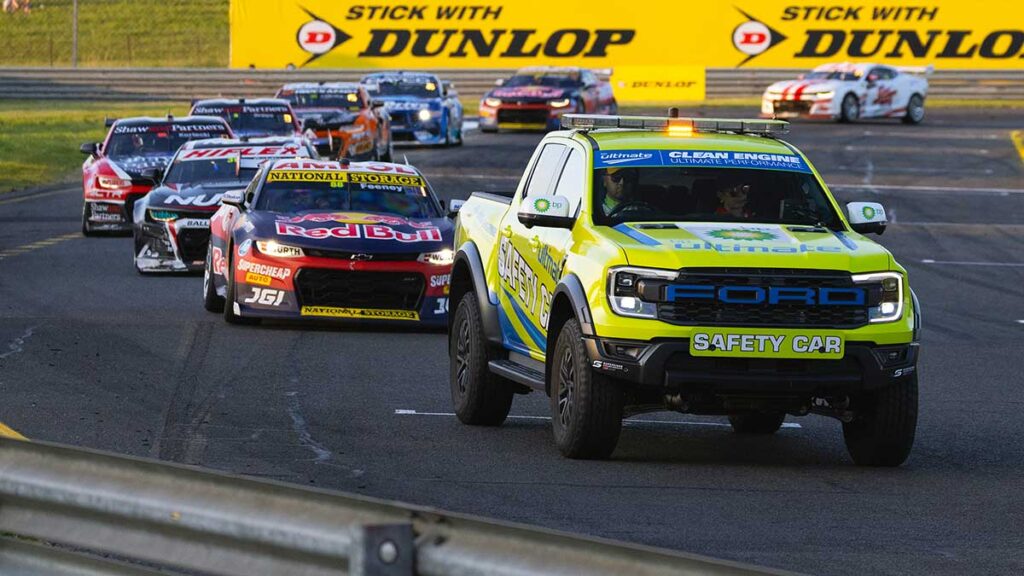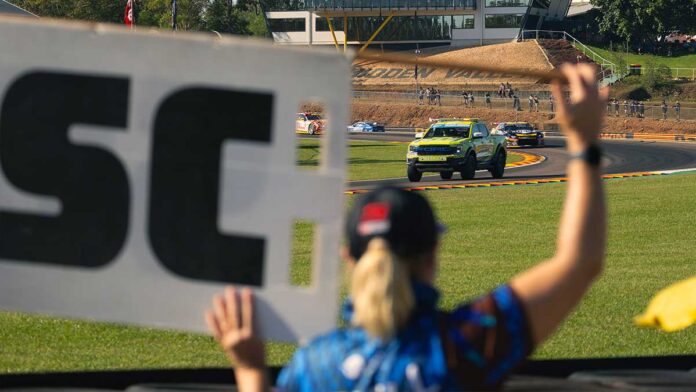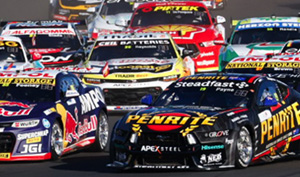THE Boost Mobile Gold Coast 500 will mark the latest step in the efforts of Supercars and Motorsport Australia to bring the field under control faster in the event of an on-track incident.
This weekend will see the first trial of a ‘Full Course Yellow’ procedure, which will force drivers to slow their cars to 80km/h to allow race officials to sort out the problem without deploying a Safety Car.
It is also planned to introduce the same slow-down procedure at the start of Safety Car periods, ending the practice of cars driving past incidents at full speed back to the first Safety Car timing line after pit exit, where the race order is frozen, to avoid losing track position.
The trials won’t take place during races this weekend but the aim is for the Full Course Yellow to be introduced to the Repco Supercars Championship races in 2024, while it will also be used at next year’s Bathurst 12 Hour.
Motorsport Australia’s James Taylor, the Race Director for Supercars, joined the Castrol Motorsport News podcast this week to detail how the Full Course Yellow procedure will work, along with its impact on the use of the Safety Car.
Here’s the rundown.
What is a Full Course Yellow?
If you’re familiar with the Virtual Safety Car in Formula 1, the Full Course Yellow is very much like that, and it has been used by the World Endurance Championship for over a decade.
The Full Course Yellow will bring the field down to a slow pace – 80km/h – to allow a situation on the track to be sorted out without the deployment of the Safety Car.
The field will also remain spread out around the track, remaining in the same relative positions, rather than packing up behind the race leader.
Also, because there is no Safety Car to get back into the pits, racing can resume as soon as it is safe to do so regardless of where the race leader is on track, instead of having to wait until the start-finish line.
How will it work?
“We’ll announce on the race management channel (RMC) that the Full Course Yellow system is activated,” Taylor explained.
From that point, drivers will have a certain period of time to slow down. This weekend, they’ll have 15 seconds to go from race speed to 80km/h.
In addition to race engineers notifying their drivers, the Gen3 cars’ digital dashboard will display a Full Course Yellow message and a visual countdown to when the 80km/h limit comes into force.
“The RMC will repeat the count from 5 to 1; ‘Full Course Yellow speed limiters must be activated in 5… 4… 3… 2… 1’,” Taylor said.
“Then every car must be at 80km/h, and they’ll proceed around until the (circuit) is cleaned.”
All Gen3 cars feature a speed limiter button on the steering wheel that will restrict them to 80km/h, much like the pitlane speed limiter keeps them from going faster than 40km/h in the lane.
Once the track is cleared, drivers will then get a five-second countdown to when racing can resume.
“We’ll make a likewise announcement – ‘Full Course Yellow ending’ – then we’ll do another count 5-to-1, and then they can turn the limiters off,” Taylor said.
V8 Sleuth’s coverage of the Boost Mobile Gold Coast 500 is proudly presented by Bad Boy Mowers – explore the world of Bad Boy Mowers with the new Spring/Summer catalogue of high-performance mowers here.
What if a Safety Car is needed?
There will be instances when a Full Course Yellow will be escalated to a full Safety Car period, but there may also be times when urgency will force Race Control to deploy the Safety Car straight away as it does now.
Under the new rules, the field won’t have to catch up to the back of the Safety Car as it currently does.
Instead, the same slow-down procedure will apply, leaving cars spread out around the circuit, all travelling at 80km/h.
Then, once the Race Director deems it safe to do so, drivers will be allowed to catch the back of the train ahead of a traditional Safety Car restart.
“The way we’ve written the procedure is that, once the incident is under control, we can make a directive to the teams that they can disengage the speed limiter to allow anyone that’s not on the back of the train to catch the train,” Taylor explained.
“For instance, if you imagine somewhere like Bathurst, we’ve got six-plus kays of track. We need to give them the ability, when it’s safe to do so, to catch the train.”
When will the trials take place?
There are three tests scheduled over the course of Friday’s running at Surfers Paradise.
The first will take place at the very start of the day, with a 10-minute session from 8:45am local time involving one car from Walkinshaw Andretti United, Tickford Racing and Matt Stone Racing.
“This will test that they’re receiving the signals and that the drivers can see and understand what they’re receiving on the dash,” Taylor explained.
The early-morning test will also be a systems test for the enhanced timing loops at the Beach Chicane that have allowed the removal of the apex tyre bundles for this year’s event.
The other two trials will involve the full field, taking place at the end of Practice 1 and Practice 2.
More trials will be held at the season-ending Adelaide 500 next month, where drivers will only have 10 seconds in which to slow down to 80km/h.

How will they determine what needs a Full Course Yellow and what needs a Safety Car?
“We’re working on a set of parameters for that at the moment,” Taylor explained.
“We’re looking at the areas where it’s going to be a quick deployment; sending a marshal trackside to pick up some debris and come back, or we may have a car that’s stopped just near an access point and we just need to push it in.”
Taylor cites the Safety Car period during the Sunday race in Townsville this year, caused by a piece of the rear crash box structure falling off Cameron Hill’s car and coming to rest on the track, as an example of something that could have been rectified under a Full Course Yellow.
“We had an issue in the last race when a fairly sizable chunk of vehicle fell off in the Turn 6-7-8 area and we had no option bar to go Safety Car, whereas that situation would give us a chance to use Full Course Yellow,” he said.
“There’s a whole heap of parameters we’re looking at (and) we’re going to have a set of operational guidelines by next year that we’ll have in place. “For example, if we have a car contacting a barrier and we have to send multiple response vehicles, that will most likely go straight into a Safety Car process.”






